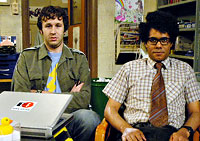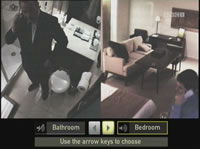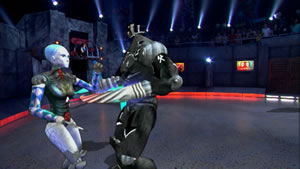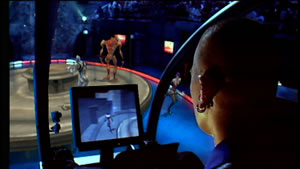Time Commanders – A Great Idea Poorly Executed
By Heidi Jacoby-Ackland
Take an award-winning PC-based war gaming program, adapt it for an educational television game show and what do you get – a missed opportunity. Time Commanders, the BBC’s attempt to capitalise on the popularity of computer gaming to reach the elusive young-ish male audience, started it’s run on BBC2 on 4 September. The concept is both adventurous and appealing in that it attempts to bring the excitement of computer gaming to television. And it’s educational in the way that BBC programming has to be in the run up to Charter Review. Yet Time Commanders is hugely disappointing and so undeniably missable that the BBC hasn’t even made a webpage for it – the sure sign that the Corporation doesn’t believe in a programme. From the very start the opportunity to entice avid gamers to partake in a television programme seemingly conceived just for them was squandered. What went wrong?
Developed utilizing the acclaimed and popular computer games engine Total War, the second episode of Time Commanders challenged a team of four National Trust co-workers from, if I recall correctly, Lyme Park to a virtual re-enactment of the Battle of Watling Road in which the Romans fought against British insurgents in AD 60. The team, divided into two “generals” and two “lieutenants,” squabbled and floundered as they attempted to command the vastly outnumbered Roman Army against the computer- generated Iceni and Trinobantes clans commanded by Boudica – soon to be portrayed on British television by Alex Kingston (of ER fame) in an ITV1 historical drama. The sad thing about Time Commanders is that it’s a game show in which the dramatic tension of the game got lost in development. Correct me if I’m wrong, but surely a battle has at least two opposing sides. Total War may be a man-versus-pc game but it isn’t a spectator sport! The great thing about Robot Wars (in a strange way, Time Commanders’ closest TV ancestor in both concept and target audience) is that the audience is introduced to both teams, gets to know each machine, hear both strategies, watch the battle, enjoy thrill of victory and the agony of defeat simultaneously. Robot Wars had two protagonists (three if you count the “house” robots) which the audience could champion. By comparison, Time Commanders is utterly tedious because the opponent, the computer game engine, has no real presence. Unless you support the contestants, there’s no one to root for; no side to take. Had Time Commanders been developed as multi-player, like Ghost Recon for instance, these problems would disappear entirely. Aside from slightly amusing in-fighting within the Roman team – or perhaps because of it – there was no doubt that this team was going to lose their battle. Whereas, of course, we know that the Romans defeated Boudica’s crew. When the outcome is a given, the journey has to have jeopardy. If the Roman team had been playing for something other than pride there might be something to see here. Perhaps a league in which the ultimate champion gets to fight a really, really big battle at the end of the series? But there’s nothing even remotely interesting about watching a team of people bicker while they, in turn, watch a large computer game kick their collective ass. The Roman team utterly failed to respond to the computer game, but that’s down to another of Time Commanders’ failures – poor player selection.
Let’s face it, this team of players last “oohed” and “aahed” over Pong because Tetris was too complicated for them. Given warrior details via Mortal Kombat-style on-screen information, the players couldn’t assimilate the information in order to develop a battle strategy. Apart from one timid team member, this group was overwhelmed by the computer graphics and were simply unable to translate the images so that they could effectively guide their army. It is hard, no IMPOSSIBLE, to believe that a team of eight-year olds would not have had a better result than this troubled foursome whose only achievement was to drive home the significance of chain-of-command and channels-of-communication in a war scenario. (Oh, and they confirmed the common logic that you should never listen to the loudest person in a meeting.) Surely Time Commanders would have been more fun to watch and potentially more educational if the production team had chosen better players. Perhaps they could have invited a team of historians to take on a team of Xbox addicts? Ex-military versus school kids? In the multi-player scenario, relevant pairings that offer even greater appeal to the target audience are easy to ponder. What pc war gamer do you know who spends his weekends touring the stately country home where Pride and Prejudice was filmed?
And, speaking of locations, the set. Here’s where the budget really pinched. Meant to look like a modern war room instead it was about as hi-tech as my grandfather’s garage. The “Generals” had a large table with blocks that represented the armies on the battlefield and croupier-type sticks (at least I think that’s what they’re called) to move the blocks around as the battle developed. But as they shouted confused orders to the “Lieutenants” who, in turn, relayed them to two unnamed people who seemed to be the only people directly interfacing with the game, the battle commenced and the massive board was altogether forgotten. If a second screen which showed a battle overview was outside the budget, then why not devote the upper left corner of the game screen, like games have had since Space Invaders? And who were the two people running the computers? They weren’t part of the Roman team – and a good thing too! But if the game technology is so complicated that regular contestants can’t run it, then what is the point of having it at all?
Who’s the actual star of the programme? Perhaps the best feature of Time Commanders is the expert commentary from the balcony. Like younger, less bitter versions of those Muppets, Statler and Waldorf, the experts’ discussion of the players’ strategies – or lack thereof – based on available historical evidence and weapons expertise, is both clever and fun. At the end of the programme the experts showed the Roman team what they could have done to beat the computer, imparting the educational bit of the programme with enthusiasm and wit. We learned how the Roman Army, outnumbered 6 to 1, defeated Boudica and her collected clans. (Or, at least we learned about the historical speculation, which isn’t quite the same thing but is intriguing and informative nonetheless.) But when the best part of a game show is not the game, you’ve got to ask some serious questions. Could the problem be the technology itself? If computer technology was at the core of Time Commanders’ development, then why was it so absent from the programme?
British indy producer Lion Television developed Time Commanders based on Creative Assembly’s award-winning war strategy engine Total War. By all accounts, the Total War series of games is outstanding. In fact, although it is still officially in development, Rome: Total War has already won quite a few prestigious awards. To my eye, the sample graphics on the website http://www.totalwar.com look ten thousand times better than anything I saw in this episode of Time Commanders. Presumably Lion used an older “working” model, perhaps from one of the earlier products in the Total War franchise, to develop their programme. If the average television programme takes approximately 18 months to two years from development to transmission, then the graphics technology Lion used was likely to be out-dated before the programme even got commissioned. While they were developing and producing Time Commanders, technology was marching forward. If you’ll pardon two consecutive puns, Lion was fighting a losing battle. In both television and gaming, good visuals are essential. But this programme was as let down by the graphics as it was by the contestants. Is the tv commissioning process just too slow to meet the expectations of the computer gaming community? Or do we not yet have the visual grammar necessary to make filmed computer games look exciting? How do you film a programme like Time Commanders? I’m not sure the programme’s director knew and, I confess, I’m not sure I know either. Camerawork is important, but the traditional multi-camera game show style used here didn’t seem to work. Based on this episode, I’d speculate that a new kind of programme making style might need to be invented otherwise the viewer will never feel close to the game’s action. And that’s a great shame because the developers are onto something good with Time Commanders.
It’s only a matter of time before a canny telly production company teams up with an even more canny game company in the concurrent development of a computer game for television. Strategy games are, by their very nature, the most obvious contenders for success if they can be developed properly. There’s big money to be made here: enormous global format markets, merchandising, film rights, etc. The profit potential alone makes it dead cert that Time Commanders is the first of a new breed of television programmes. Although the end result is not particularly satisfying or successful in this instance, kudos are due to Lion and Creative Assembly for being the first to recognise an opportunity and go for it. Time Commanders 2.0 will be fantastic.
 We all know that the Web is all about Trust, don’t we … and those companies that do not prove that they’re trustworthy will lose out.
We all know that the Web is all about Trust, don’t we … and those companies that do not prove that they’re trustworthy will lose out. In a significant new development, Channel 4 will be allowing their viewers to watch their new comedy program, ‘The IT Crowd’ online and on-demand in advance of their TV broadcast.
In a significant new development, Channel 4 will be allowing their viewers to watch their new comedy program, ‘The IT Crowd’ online and on-demand in advance of their TV broadcast. The online debut is a first for a terrestrial broadcaster in the UK and apes a similar strategy employed by US network NBC, which launched the US version of The Office online last year.
The online debut is a first for a terrestrial broadcaster in the UK and apes a similar strategy employed by US network NBC, which launched the US version of The Office online last year. Channel 4 are saying that this is the first time that they’ve premiered a full episode of a new series, adding that they find it “particularly exciting ” to be airing such a “high profile and apposite programme.”
Channel 4 are saying that this is the first time that they’ve premiered a full episode of a new series, adding that they find it “particularly exciting ” to be airing such a “high profile and apposite programme.” The program has already received substantial online coverage already with sites like MSN, Yahoo! and Wanadoo running features, and Channel 4 are hoping that the coverage will help in pull in viewers.
The program has already received substantial online coverage already with sites like MSN, Yahoo! and Wanadoo running features, and Channel 4 are hoping that the coverage will help in pull in viewers. More recently the BBC has claimed to offer yet another enhanced drama first with interactive Spooks. The third series of this successful spy drama began transmission on BBC1 Monday 11 October. Unlike Family Affairs’ tentative foray into interactivity, viewers will not be voting on Spooks storylines. (If they could, they’d most certainly vote to keep Tom Quinn, the main character played by Matthew Macfadyen who exits the show in Episode 3.) Instead immediately after the programme, digital viewers are invited to find out if they have what it takes to make it as a spy. Led by Harry Pearce (a crossover character from the television series portrayed by Peter Firth), participants take a series of scored tests that examine essential espionage skills such as memory, reaction and observation. From Episode 6 viewers will be able to participate in a mission that was written by Steve Bailie, an experienced writer of television drama. “The aim,” Sophie Walpole BBC’s Head of Interactive Drama & Entertainment told us, “is to offer fans a deeper relationship with both the programme and its characters.” In addition, Walpole pointed out, “fans will get something back – they’ll get to know a little about themselves.”
More recently the BBC has claimed to offer yet another enhanced drama first with interactive Spooks. The third series of this successful spy drama began transmission on BBC1 Monday 11 October. Unlike Family Affairs’ tentative foray into interactivity, viewers will not be voting on Spooks storylines. (If they could, they’d most certainly vote to keep Tom Quinn, the main character played by Matthew Macfadyen who exits the show in Episode 3.) Instead immediately after the programme, digital viewers are invited to find out if they have what it takes to make it as a spy. Led by Harry Pearce (a crossover character from the television series portrayed by Peter Firth), participants take a series of scored tests that examine essential espionage skills such as memory, reaction and observation. From Episode 6 viewers will be able to participate in a mission that was written by Steve Bailie, an experienced writer of television drama. “The aim,” Sophie Walpole BBC’s Head of Interactive Drama & Entertainment told us, “is to offer fans a deeper relationship with both the programme and its characters.” In addition, Walpole pointed out, “fans will get something back – they’ll get to know a little about themselves.”  30-something nostalgics, rejoice: a new series of Roobarb and Custard is in production. IP owners and new series Executive Producers, A+B Productions have started work at Monster Animation Studios in Dublin. To be distributed by Celador, Roobarb and Custard Too uses hand-drawn and hand-animated cells coupled with modern production processes to produce a cartoon that is faithful to the original series.
30-something nostalgics, rejoice: a new series of Roobarb and Custard is in production. IP owners and new series Executive Producers, A+B Productions have started work at Monster Animation Studios in Dublin. To be distributed by Celador, Roobarb and Custard Too uses hand-drawn and hand-animated cells coupled with modern production processes to produce a cartoon that is faithful to the original series. After all the hype, the BBC’s virtually-virtual gameshow Fightbox [
After all the hype, the BBC’s virtually-virtual gameshow Fightbox [ over-the-shoulder shots (right) of the contestants which showed them in their pod displaying their computer monitor action in the foreground, in the middle-ground the virtual arena action and finally the real arena and audience action in the background. In another, there was a low shot from the arena floor looking up through one of the virtual challenges, the helix. Both these shots, amongst others, helped to create depth of vision, contributing a sense of scale and density to the action. At no point did the huge arena appear to be empty even though, in the “Real World” it was. (In reality, the studio audience watched the gaming on a massive screen.) I ought to mention the graphics too. Although gamers’ expectations are always increasing, visually the graphics in Fightbox are fairly good. There was a consistency between the studio lighting and the graphics which was so good that virtual shadows were created which matched the real ones. Now that’s attention to detail!
over-the-shoulder shots (right) of the contestants which showed them in their pod displaying their computer monitor action in the foreground, in the middle-ground the virtual arena action and finally the real arena and audience action in the background. In another, there was a low shot from the arena floor looking up through one of the virtual challenges, the helix. Both these shots, amongst others, helped to create depth of vision, contributing a sense of scale and density to the action. At no point did the huge arena appear to be empty even though, in the “Real World” it was. (In reality, the studio audience watched the gaming on a massive screen.) I ought to mention the graphics too. Although gamers’ expectations are always increasing, visually the graphics in Fightbox are fairly good. There was a consistency between the studio lighting and the graphics which was so good that virtual shadows were created which matched the real ones. Now that’s attention to detail!